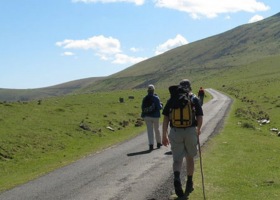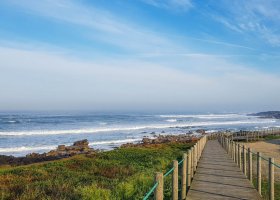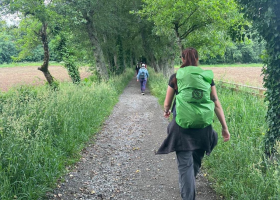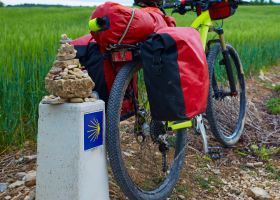
Create your own journey; Experience the best of Northern Spain at your own pace
This website uses its own and third-party cookies, for the proper functioning of the site and to generate usage statistics.
By continuing to browse we understand that you consent to our �ookie policy
Explore the Historic Camino Primitivo de Santiago Route from Oviedo to Santiago de Compostela. Traverse the original path taken by King Alfonso II in the 9th century, now a popular pilgrimage blending challenging trails with the breathtaking scenery of Asturias.
Begin your journey at the iconic Cathedral of Oviedo, and venture through the rugged mountains and dense forests of Northern Spain. The Camino Primitivo, characterized by its steep and narrow paths, offers a deeply reflective and intense pilgrim experience.
Immerse yourself in the rich culture and warm hospitality of Spain’s traditional villages. Conclude your pilgrimage at the spiritual and historic heart of Santiago de Compostela Cathedral.
Ideal for adventure enthusiasts and seasoned hikers, the Camino Primitivo de Santiago invites you on a transformative journey, rich in history, culture, and natural beauty.Click on request a quote (on the right column) and receive a personalized offer for your trip with no binding commitment.
The Camino Primitivo offers a more 'primitive' experience with fewer towns and services compared to the French route. Therefore, we include a daily picnic-style lunch from Oviedo to Lugo. Hotels along this route are limited, which restricts flexibility in stage variation. Despite this, we have selected charming and quality accommodations. It's important to note that only 3% of pilgrims choose this route due to its level of difficulty.
✔ Daily departures.
✔ Carefully selected hotels, always with a private bathroom.
✔ A personalized digital guide from Spain is More with practical information about the route and recommendations.
✔ Stage customization: Possible on a few occasions.
✔ If you have time, we advise spending two nights in Oviedo. It's a beautiful city that truly deserves a detailed visit.
✔ The Roman Wall of Lugo. Lugo is a small city, but its Roman wall is exceptional. If you want to spend a little more time in Lugo, we recommend adding an extra night to your itinerary.
![]()
Click here to explore the Camino Primitivo
Find key insights on distances, terrain, climate, and vital tips.
Camino De Santiago: Primitivo Way
(Oviedo - Santiago)

You will probably arrive via the high-speed from Madrid to Oviedo, depending on where you come from. Spain is More can include your airfare and/or local transportation upon request.
The Asturian capital of Oviedo is an elegant city, both in its architecture, its variety of restaurants and its cultural scene, which is among the most-recognized in Spain. The city's history dates back to 761 and much of the old town is marked by its long history.
Since the Middle Ages, the city has been a popular destination for pilgrims who visited the San Salvador de Oviedo Cathedral.
As a kingdom Asturias has a long, exciting and glorious history. The Spanish successor to the throne bears the title of "Princess of Asturias" until her coronation. This is partly due to Asturias’s important role in the war against the Moors, and thus the creation of the Spain we know today.
But the king also had an important role in relation to the pilgrimage route through Spain. In the 12th century. King Alfonso II made the first known pilgrimage to what was then called "Campus Stellae" (Compostela), to found the Cathedral of Santiago, which was meant to hold the remains of the Apostle James ("Santiago" in Spanish). It was the king who subsequently spread the word about this pilgrimage, which is today considered one of the three most important Christian pilgrimage routes in the world.

From the Cathedral El Salvador the Camino leaves Oviedo and quite quickly you will find yourself in a rural setting which will by typical of the next several stages.
This stage is characterized by passing through relatively many villages along the way, and it is clear that the nearby highway is the lifeblood of the area. The difference is clearly seen when the highway ends at about stage 1 - 1,5 later.
Distance: 25 Km

A beautiful hike through typical Asturian landscape with soft, green hills in rural location. The stage is the easiest on this side of Lugo and it follows, for the most part, the banks of the Nonaya River.
The village of Salas is filled with history, with its beautiful stone houses, a church from 1549, a palace and a singular tower. The village was declared "protected” in 1994.
Distance: 22 Km

From the beginning of today's stage, you will have a gentle but long climb to the city of Tineo.
When you reach the ridge you will have an incredible view of the valley, and the last miles before Tineo are pure pleasure with green hills as far as the eye can see. Tineo is a relatively large mountain village with good restaurants and a few shops, etc.
Distance: 20 Km

During this stage, you will constantly be on your way up or down. It is one of the most difficult stages. At the same time, it’s one of the most beautiful and most deserted stages of all Camino de Santiago stages.
Distance: 28 Km

This stage is the toughest on the Camino Primitivo, as you must pass the Puerto del Palo (1,120 meters), and because the stage is long and unfortunately cannot be shortened. However, it is possible to take a taxi the first 7 kilometers from Pala de Allande to the top of the Puerto del Palo, from where the stage is much easier. In terms of scenery: beautiful.
Distance: 22 Km

Distance: 17 Km

From Grandas de Salime the Camino continues through the beautiful landscape. The terrain is easier even if a couple of hills must be passed, when you dross from Asturias to Galicia.
Distance: 26 Km

This is a difficult – mainly due to a couple of tough climbs – but generally hilly stage, in particular, the one-kilometer ascent from A Lastra, which has the highest grade of ascent on the Camino Primitivo.
Distance: 25 Km

The terrain becomes somewhat more level as you get closer to Lugo. This stage can be shortened to 8 and 23 kilometers by extending the trip with an extra night . Lugo's greatest treasure (and what a treasure it is!) is its 2 kilometer long, 8-12 meter high and more than 4 meter wide Roman city wall from the third century (1.25 miles long, 26-40 feet high and 13 feet wide). The wall is well-preserved and its dimensions are impressive. It is the best-preserved Roman city wall in the world and a stroll on it is a majestic experience that offers stunning views of the city. The second most important monument is the Cathedral of Santa Maria. Around the cathedral you will find narrow streets that criss-cross the Old Town, creating a pleasant and cozy atmosphere.
Distance: 30 Km

The stage is the easiest so far, which is perhaps quite welcome. You've come down from the heights and have thus returned to the forest and are closer to rivers and lakes. The area is rural with fields and small farming communities. An idyllic stage.
Distance: 27 Km

This final stage of the Camino Primitivo on the route links up with the French Camino for the last three stages prior to Santiago de Compostela. In many ways, the stage is similar to yesterday's stage, passing mainly through woods and fields.
Distance: 28 Km

On the French route, you will meet several walkers and cyclists and also a far greater range of restaurants, larger villages etc. than you have been used to. Although there are no hard climbs on the stage, it is ascending and descending constantly, but not, however, to the same extent as you are used to by now.
Distance: 26 Km

Congratulations, you achieved an admirable goal, so it's time for a number of traditional pilgrimage rituals. First, be sure to get proof of this feat: the last stamp in your pilgrim passport. Along with the rituals, enjoy the End Station of the Pilgrim route, Santiago de Compostela, which offers a veritable cornucopia of attractions and one of the world’s most important cultural centers.
This university town exudes charm and has a myriad of cozy streets offering ample opportunity to sample the many local delicacies.
The cathedral is surrounded by a historic center which is on UNESCO’s World Heritage Site list, and old town is incomparable. Its monuments stand as true works of art in different architectural styles.
Distance: 19 Km

True pilgrims continues further and finish their journeys in Finisterre. The tour goes by bus with an English-speaking guide from Santiago to Finisterre in the morning and returns mid-efternoon to Santiago. Just off the stunning, rugged coastline and the fabled “Costa de la Muerte” (Death Coast), a reef filled with shipwrecks and tales of legends captures a raw, natural beauty. On the coast’s westernmost point is Finisterre – meaning the world’s end. Romans named this coast because it was literally the end of the known world. For many pilgrims this is the symbolic endpoint of the pilgrimage.
The evening is spent in Santiago de Compostela.

Departure from Santiago

Pilgrimage from France to the vineyards of La Rioja crossing the Pyrenees
9 days / 8 nights
From 650 Euro/pers.

Pilgrimage along the St. James Way from Porto to Santiago along the coast.
16 days / 15 nights
From 1250 Euro/pers.

Pilgrimage along the last 116 km from Sarria to Santiago.
8 days / 7 nights
From 630 EUR/pers.

Pilgrimage by bike through incredible landscapes
9 days / 8 nights
From 850 EUR/pers.

Results of research into the psychological benefits of a camino announced

njoy the Camino with the best planning